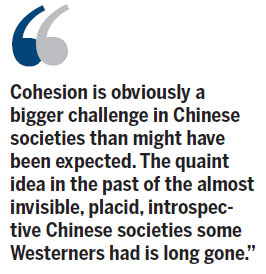Mobility has shown stark differences among Chinese
Updated: 2014-05-23 05:09
By Kerry Brown(HK Edition)
|
|||||||||
Mobility is a feature of modern life. A recent map produced by Scientific America vividly showed global flows (http://blogs.scientificamerican.com/observations/2014/03/28/global-migrant-flows-an-interactive-map/). The graphs showed that the strongest continental links in the last decade were between Latin America, Europe and North America, and South Asia and North America. But by far the largest flows were within continents, with massive movements within South Asia and Africa.
It is likely that if one were to put the internal movements within a country rather than a continent onto a map like this, even if that were possible, then the internal migration within the Chinese mainland and Hong Kong would dwarf anywhere else on the globe. Up to 230 million people are migrant laborers in China, according to the 2010 census. In the space of a few years, another 20 percent of the country will be expected to move into the cities. This movement of people is unprecedented.

And it affects Hong Kong too, because of the short and long-term movement of people across the border of the special administrative region in ways which could never have been expected even a decade ago. In 2013, a staggering 17 million mainlanders transited, stayed in or moved to Hong Kong. If the mainland is in a ferment of mobility for its people now, then Hong Kong exists at the frontier of this.
Many Chinese might be puzzled that the world often attributes their societies to having a strong collective identity and cohesion. In Europe, Australia, and North America, Chinese communities are often lazily placed together in a homogenous category, with few people able to discern the real diversity that exists within these communities. Policy-makers often think that the term "Chinese" covers everything, and that the sort of stark differences they see in, for instance Africa and Latin American identities, at least is not something that should worry them when thinking about the Chinese.
They would be wrong. China's internal diversity, despite the uniformity so often attributed to ethnic Chinese, is starkly clear in the case of Hong Kong, with the recent appearance of problems of disharmony and lack of cohesion that might surprise outsiders. The case of the mainland parents, who allowed their child to urinate publicly in Hong Kong, and the anger this produced among bystanders in mid-April deserves close attention in this context.
The simple fact is that in a very short space of time, mainland Chinese are now freer to travel and leave the mainland than ever before. This has provided a steep learning curve for everyone involved. For many mainlanders, the experience of going abroad, as travelers, migrants, or even just day trippers, has been a mixed and complicating one. It has widened their eyes and allowed them to see the world a little more clearly. Ideals about an outside world where everything is perfect have long faded.
For Hong Kong, the issue is even starker. Superficially, a number of features of people and society in Hong Kong and the mainland seem to be very similar - much of the written language, the food, family structures, and people's appearance. But as always, the things we expect to be most similar to us, when they show differences are often the most disorientating and hardest to deal with. Tiny differences in the way people behave, the way they speak in public, the way they eat, the way they dress can become very visible. White Europeans or North Americans are expected to be different. But for people who are ostensibly ethnically from the same group, differences are harder to expect and sometimes more unsettling when you notice them.

Cohesion is obviously a bigger challenge in Chinese societies than might have been expected. The quaint idea in the past of the almost invisible, placid, introspective Chinese societies some Westerners had is long gone. We now see a world of Chinese in which people from Fujian, or Guangdong, or Shanghai, or the Northeast, are very different in their relations with each other, and in their dialects, diets and deportment. Hong Kong's experiences of trying to create a balanced society in the midst of such dramatic and radical mobility are ones the rest of the world needs to be supportive of and pay attention to.
Clearly many local people in Hong Kong are starting to feel the same sense of being threatened or disrupted reported in European or other countries where rapid migration is occurring. Prejudice has started to rear its ugly head. The scenes of the parents with their infant berating, and then being berated, by a crowd in mid April which were caught on film and placed on the Internet are symptomatic of this.
The world needs to pay more attention to cohesion within Chinese communities, not just assume that they are unified and pay no heed to their internal challenges. And Hong Kong evidently needs to have social models that are more tolerant, accepting and stable in order to engage with this extraordinary movement of people. The debate about migration and how to engage with it and have policies that control it is never an easy one for any society to have. Hong Kong is at the epicenter of this now, and its responses are of global significance.
The author is executive director of China Studies Center and professor of Chinese Politics at University of Sydney; team leader of the Europe China Research and Advice Network (ECRAN) funded by the European Union; and associate fellow at Chatham House, London.
(HK Edition 05/23/2014 page9)